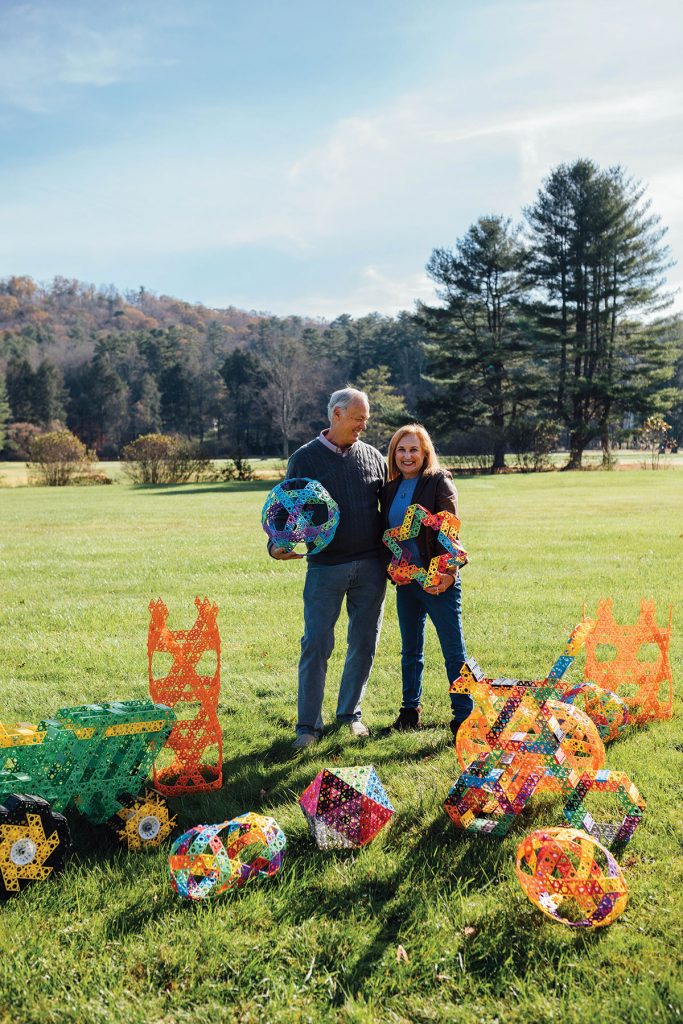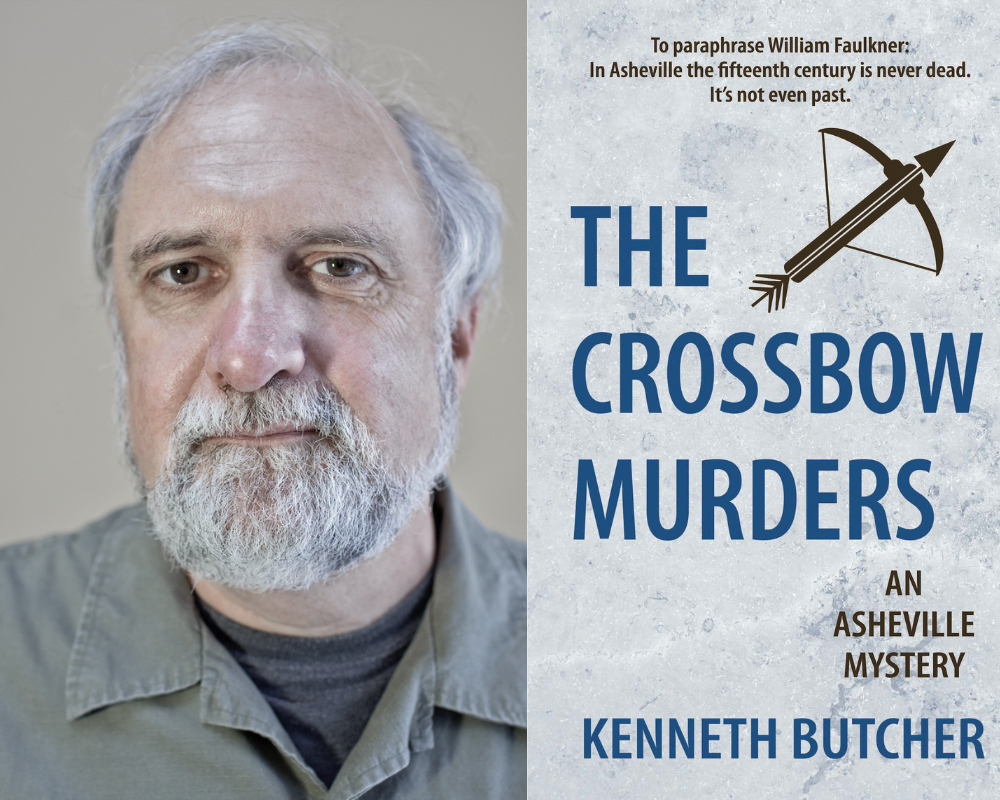Local inventors go big with geometry-influenced construction toy

A DREAM TAKES SHAPE
Mark and Lisa Burginger and their Qubits.
Photo by Rachel Pressley
Lisa and Mark Burginger owe a lot to Archimedes. Besides proving a laundry list of geometrical theorems, the Greek mathematician invented the icosidodecahedron and cuboctahedron — two impossible-to-pronounce polyhedrons that underpin the Hendersonville couple’s business, Qubits® Construction Toy (qubit is shorthand for “quantum bit,” the basic unit of quantum information).
Like LEGO bricks, Qubits are building toys that snap together to make castles, cars, catapults, and everything in between. But unlike its multibillion-dollar competitor, Qubits offers larger pieces that are made from pliable, food-grade plastic, which means they bend with a child’s imagination.

This John Deere replica is outstanding in its field.
Photo by Rachel Pressley
“Kids can make a whole family of polyhedrons,” says Mark. “The shapes they create, even those that are new and potentially never before discovered, all link back to the two ancient, geometric shapes Archimedes invented in 214 B.C.”
Mark belongs to a shrinking group of adults who can recite the Pythagorean Theorem, no problem. He gushes about triangles, a shape that is ubiquitous sub-atomically, like someone would a favorite local watering hole. In the 1980s, Mark was even pen pals with Buckminster Fuller, an American inventor who patented the geodesic dome in response to housing shortages after World War II (he has long been associated with avant-garde midcentury institution Black Mountain College). Spaceship Earth at Walt Disney World in Orlando is an example of the industrious, spherical design.

SHINY, HAPPY, INDESTRUCTIBLE
Qubits, made of a similar plastic as Tupperware, are produced locally at Gap Creek Tool & Mold.
Photo by Rachel Pressley
In short, Mark breathes geometry. After studying graphic arts at San Jose State University and spending four years in the Air Force, he pursued a degree in architecture at the University of Arizona. In 2004, he became a registered architect in California, busying himself with residential and commercial projects. “Then, in 2007, everything went kaput,” Mark says, referring to the recession.
He soon swiveled his attention to a decades-long project that started when his art teacher at Ernest Righetti High School in Santa Maria, California, asked students to make modular forms. Mark created an inherently complex structure, earning an “A” in the class. But the assignment didn’t stop there. Through college, he made more and more cardboard models, stowing them away in a box. Decades later, when his kids’ school cancelled all art programs, he and Lisa brought the cardboard models to the classroom. The students loved them.
“That was the beginning,” says Lisa.

Photo by Rachel Pressley
Qubits was patented in 2005, and the Burgingers started selling the toy commercially in 2007, when Mark’s architecture work slowed to a halt. In July 2009, he took the concept to Shark Tank, the ABC reality show in which budding entrepreneurs pitch to a group of investors. Daymond John, founder of the urban-apparel line FUBU, offered Mark a contingency deal: If a major toy distributor purchased Qubits, then he would invest. A hard pitch was made to Hasbro. They passed, knowing that their own line of construction toys would hit stores in Fall 2011, and John’s offer crumbled.
Undeterred, Mark and Lisa pursued a distribution deal with Discovery Toys from 2011 to 2012. In 2015, they received a $100,000 Mission Main Street Grant from Chase Bank, and two years ago, after a vacation to Western North Carolina, they moved to Hendersonville, partnering with Gap Creek Tool & Mold, Inc., based in Fairview, to produce their toy.
To date, the business has sold more than one million Qubits pieces to schools, museums, and parents.
“Schools are our biggest market, especially with the popularization of STEM education,” says Lisa, referring to the push for science, technology, engineering, and mathematics-based curricula over the past 15 years.
Though students are provided with instruction manuals detailing quirky structures like the Megastar and Vortex, they tend to “go crazy with their own shapes,” says Lisa. In 2017, for instance, sixth graders at Wadsworth STEM Academy in Palm Coast, Florida, built a 17.5-foot tower using nearly 300 pounds of Qubits. Students have also created bowling balls, tractors, and stars. College students use the construction toy, too, snapping the pieces together to replicate complex snowflakes and (a sign of the times) virus structures.
But with face-to-face learning limited for the time being, Qubits are also a parent’s saving grace. At about $35 for 50 pieces, the hands-on manipulative is an affordable alternative to screen-based activities. Plus, Qubits are pretty much indestructible. “They are basically made from Tupperware,” says Mark. “You don’t see Tupperware breaking, do you?”
And much like the container storing your leftover lasagna, Qubits are dishwasher safe.
“That has been huge during COVID-19,” Lisa says. “We’ve had some teachers and parents tell us that they’re throwing away wood blocks, plush toys, and other things they just don’t know how to clean.”
As of 2020, Qubits can also be described as “out of this world.” After all, Buzz Lightyear and LEGO figurines have already blasted to space — so Mark posted a few Tweets about wanting to send Qubits into the stratosphere, too. A guy out west with a high-altitude balloon answered the call. In July, eight Qubits pieces were launched nearly 20 miles into the air from the Black Rock Desert in Nevada. The toy dropped at 600 miles per hour. And yes, it remained intact.
“You know, we’ve had our ups and downs this year,” says Mark. “But we do this because we love teaching the kids. We do this because it makes us feel good.”
Lisa and Mark Burginger, Hendersonville. Qubits Construction Toy can be purchased online at qubitstoy.com or on Amazon. The Burgingers will be selling Qubits at the Hendersonville Farmers Market’s Holiday Market on Saturday, Dec. 5, 8am-1pm at the Historic Train Depot (650 Maple St.), 828-233-3216, hendersonvillenc.gov, “Hendersonville Farmers Market” on Facebook.



